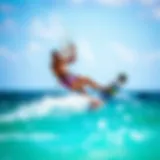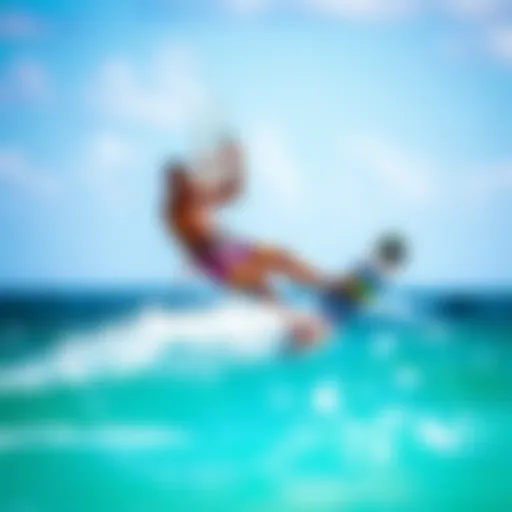The Essence of Surf Kite: An In-depth Exploration
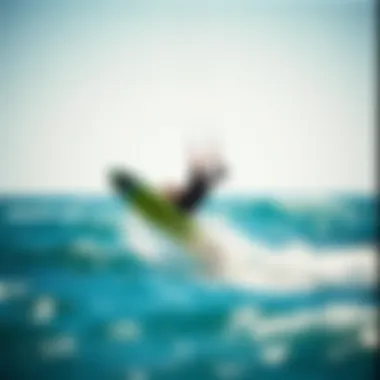

Intro
Surf kiting, a dynamic blend of surfing and kiteboarding, has seen surges in popularity over the past few decades. It’s not just about gliding across the waves; it’s an experience steeped in excitement, skill, and a sense of community. For both old-timers and newcomers, the allure of harnessing the wind and riding the surf offers a thrill that’s hard to match.
In this exploration, we dive into the intricate facets of surf kiting, dissecting its history, diving into various techniques, exploring gear, identifying prime locations, and emphasizing safety protocols. Ultimately, the goal is to enrich your understanding of this exhilarating sport while promoting environmentally-friendly practices that protect our precious water environments.
Gear Selection
To truly embrace surf kiting, understanding gear is essential. The right equipment can make the difference between a challenging outing and a memorable adventure.
Types of Kites
When it comes to kites, they aren’t all created equal. Varieties such as the C-Kite, Delta Kite, and Bow Kite each serve distinct purposes and offer varied flying characteristics. If you're a beginner, a Bow Kite might be your best bet, thanks to its stability and ease of use. The C-Kite brings superior performance and is favored by experienced riders wanting extreme maneuvers, while the Delta Kite strikes a balance between performance and accessibility. Understanding these differences can help you select a kite that matches your skill level and riding style.
Choosing the Right Board
Your board, akin to your kite, plays a significant role in performance. Surfboards and twin tips represent two primary categories. For those wishing to ride waves efficiently, a surfboard will help you navigate the swells with grace. Meanwhile, twin tip boards offer versatility on flat water and are more forgiving when it comes to jumps and tricks. It's also crucial to consider the board's size; larger boards can offer more stability for beginners, while more seasoned surfers may prefer smaller boards for their agility.
"Selecting the right gear sets the stage for mastering the sport and enhances your overall enjoyment."
Skill Development
Mastering surf kiting requires more than just having the right gear. Continuous skill development is key.
Essential Techniques
As you begin, mastering the fundamentals is vital. This includes learning to control the kite—essentially, how to steer it effectively while maintaining balance and focus. Techniques such as the water start are crucial, allowing you to rise from the water and ride the waves seamlessly. Moreover, each trick, whether it’s a basic jump or a more complex maneuver, builds on previous skills.
Progression Tips
Progressing in surf kiting is akin to climbing stairs—each step is essential to reach the top. As you grow comfortable with basic techniques, don’t rush to perfect everything at once. Instead, focus on incremental improvements. Consistent practice in diverse conditions will make you more adaptable to changing environments. Engaging with the surf kiting community can provide insights, tips, and support, ensuring you develop both skills and friendships.
In summary, surf kiting is as much about personal growth and community as it is about the thrill of riding the waves. With the right gear and techniques, anyone can dive into this exciting world.
Preface to Surf Kite
The world of surf kiting offers a mesmerizing blend of adrenaline and artistry. As the wind fills the kite, riders feel an invincible connection between themselves, the board, and the ocean’s waves. This section aims to demystify surf kiting, providing readers with essential insights about its nuances. Understanding the significance of this thrilling sport will be vital for anyone looking to grasp its fundamentals deeply.
Understanding the Basics of Kiteboarding
At its core, kiteboarding combines elements of surfing, windsurfing, and paragliding. The basic premise is simple: a rider harnesses the power of the wind through a large fabric kite, propelling themselves across water while they stand on a board. Critical concepts within kiteboarding include kite size selection, wind conditions, body positioning, and riding techniques.
For beginners, establishing a foundation in kiteboarding not only involves mastering the equipment but also getting acquainted with the surrounding environment. Precise knowledge about wind patterns, tides, and local regulations is fundamental to ensuring a safe experience.
- Kite Size: Choosing the right kite is essential. Larger kites work well in lighter winds, while smaller ones are designed for strong winds.
- Wind Conditions: Understanding that not all days are suitable for kiteboarding is crucial. Weather apps often provide helpful real-time data.
- Body Positioning: Proper stance can greatly aid in stability; bending the knees can absorb the board’s impact against the waves.
- Riding Techniques: Starting with basic movements before advancing to jumps and tricks helps in building confidence and skill.
As novice riders pick up these foundational skills, they'll find that kiteboarding is not just physically engaging but also mentally stimulating, engaging users in a heightened state of awareness of their surroundings while they ride.
The Evolution of Surf Kiting
Surf kiting has undergone a remarkable transformation since its inception. Originally, the sport drew inspiration from various sources, from traditional surfing to early kitesurfing techniques demonstrated in the 1980s. It was in the late 1990s that surf kiting began gaining traction as a distinct sport, evolving alongside advancements in equipment technology.
The advent of more efficient kite designs and materials propelled the sport into a new era. Foil kites emerged, offering enhanced performance, stability, and versatility. These kites require a different handling technique but can deliver a performance that thrills riders in diverse conditions.
Additionally, surf kiting festivals and competitions have blossomed from local gatherings into international events. This sense of community fosters camaraderie among riders, spurring innovation and sharing knowledge to elevate the sport.
"The journey from amateur to expert in surf kiting is often peppered with challenges, but the rewards are unmatched. Each ride tells a story of personal growth and communal connection."
The evolution of surf kiting mirrors broader shifts in our society's approach to adventure sports: accessible yet demanding, thrilling yet grounded in respect for nature. As one continues to engage with the sport, they not only face the challenge of progression but also become part of a vibrant culture that champions safety, responsible practice, and environmental stewardship.
Essential Gear for Surf Kiting
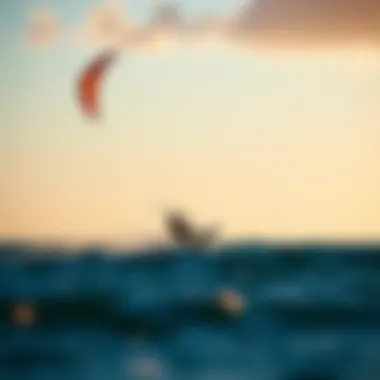

When it comes to surf kiting, having the right gear isn't just a matter of preference; it's a matter of safety and performance. Each component plays a crucial role in how effectively and safely you can enjoy the sport. Choosing the right equipment can significantly enhance your experience out on the water. Here’s a closer look at the essentials you’ll need.
Kites: Types and Specifications
Different types of kites are designed for varying conditions and levels of skill. Understanding the specifications helps kiteboarders make informed decisions. Here are a few types:
- SLE Kites (Supported Leading Edge): These are stable and good for beginners but can handle higher winds too.
- C Kites: More advanced, these offer excellent control, perfect for tricks and jumps, though they require more skill to handle well.
- Bow Kites: Popular for their adjustable power and stability, they're great for all skill levels and work well in lighter winds.
Key Specifications:
- Size: Generally measured in square meters, larger kites generate more power but require more skill.
- Aspect Ratio: This relates to the width and height of the kite. Higher aspect ratios are more efficient but less stable.
- Material: Durability often comes from the fabric used; lighter materials are good for performance but need to withstand abrasions.
Taking your time to assess these details can make a world of difference when you hit the surf.
Boards: Selecting the Right One
Choosing the right board is all about matching your style and skill level. Boards come in various shapes and sizes, each designed for different conditions.
- Directional Boards: Ideal for surfers who want to ride with the waves, these boards maneuver well in surf conditions.
- Twin Tips: Versatile and easy for tricks, perfect for those looking to do freestyle kiting.
- Hybrid Boards: As the name suggests, these boards combine features of both directional and twin tips, making them a great choice for all-around performance.
Considerations When Choosing a Board:
- Riding Style: Are you more into freestyle or wave riding? Pick accordingly.
- Weight: Heavier boards can offer more stability but less maneuverability.
- Skill Level: Beginners might want wider, more stable boards, whereas experienced riders might prefer something narrower for agility.
Selecting the perfect board can feel like searching for a needle in a haystack, but it’s vital for elevating your experience on the water.
Safety Equipment: Protecting Yourself
Safety shouldn't take a back seat in surf kiting; being well-prepared is essential. The right safety gear could be the difference between an enjoyable session and a troubling one. Here’s the basic rundown of what you’ll need:
- Impact Vest: Provides buoyancy and protection against falls.
- Helmet: Essential for protecting your head from unexpected impacts, especially in overcrowded spots.
- Wetsuit: Keeps you warm in cooler waters and adds some extra buoyancy.
“Safety doesn't happen by accident; it requires an active effort.”
Additional Gear Might Include:
- Leashes: Keeps your board close even when wiped out.
- Floatation Devices: Particularly useful in choppy waters or strong currents.
- Signal Flags: Useful for visibility when conditions are hectic.
Choosing the right safety gear often requires an investment, but the payoff is a secure and more enjoyable ride.
In summary, investing in high-quality, appropriate gear ensures you not only enhance your skill and enjoyment while surf kiting but also helps keep you safe while you are out there chasing the waves and the wind.
Techniques and Skills in Surf Kiting
Techniques and skills play a critical role in the world of surf kiting. Mastering these areas is what separates the casual participant from the dedicated enthusiasts. Whether you're just starting or aiming beyond basic rides, understanding the intricate skill sets involved is vital. Not only do they enhance your performance, they also ensure safety and sustainability in this exhilarating sport. A solid grasp of foundational techniques allows kiteboarders to execute advanced maneuvers, turning an ordinary session into a memorable adventure. This section dives deep into the skill ladder, from beginner to advanced stages, helping you navigate the complexities of surf kiting.
Fundamental Skills for Beginners
For those dipping their toes into surf kiting, starting with fundamental skills is absolutely key. These skills lay the groundwork for future success and exploration in the sport. Learning how to control your kite properly is step number one. It’s not just about flying it; it's about feeling its responsiveness in different wind conditions. A strong focus on practicing basic kite control can boost your confidence tremendously.
Some essential skills include:
- Launching and Landing: Knowing how to launch and retrieve your kite safely can help avoid accidents, especially when others are around.
- Riding Upwind: This skill is crucial; if you can’t ride against the wind, you’ll find yourself drifting far from your launch point.
- Turning Techniques: Learning smooth transitions while riding keeps your momentum up and prevents unnecessary falls.
"The first step in surf kiting isn’t about the jumps or tricks; it’s about getting comfortable with the kite. Once you’ve got that under control, the fun starts!"
Advanced Maneuvers and Tricks
Once you’ve mastered the basics, the world opens up with advanced maneuvers and tricks. This is where creativity meets skill. For kiteboarders looking to impress onlookers or elevate their game, learning tricks like jumps, spins, and flips can provide immense satisfaction. However, attempting these moves requires a deep understanding of physics and body mechanics.
Some popular advanced moves are:
- Kite Loops: This move involves pulling the kite sharply, causing it to loop in the air while providing lift.
- Handle Passes: A challenging trick where you pass the handle of the control bar from one hand to the other during a jump.
- Back Roll and Front Roll: These are 360-degree turns that add flair to your jumps, making for exciting displays of skill.
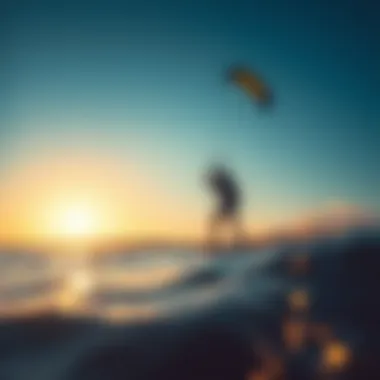

Keep in mind, to safely attempt these tricks, you should progressively build your strengths and refine your technique.
Balance and Control Essentials
Balance and control sit at the heart of surf kiting. These are not just physical attributes but also mental dynamics that contribute to your overall performance. Being able to stay balanced on the board while controlling the kite is fundamental for executing both basic and advanced moves alike. Riders must develop core strength and understand how to position their bodies relative to the kite and the board.
Key components to consider include:
- Weight Distribution: Properly shifting your weight can significantly help with turns, jumps, and landings.
- Kite Position: Keeping the kite at the right angle in relation to the wind is crucial for maintaining power and stability.
- Focus and Mindset: Staying calm and focused will enhance your decision-making, which is essential when attempting tricky maneuvers.
As you refine these skills, remember that consistency and practice go hand in hand. Join local training sessions or find a mentor who can provide guidance as you venture into more complex territories of surf kiting.
Developing these techniques and skills enhances not just your proficiency but the thrill you derive from surf kiting, making each ride something worth cherishing.
Optimal Locations for Surf Kiting
Finding the right place to surf kite significantly influences both the experience and the progression of one's skills. The beauty of this sport lies in its versatility, allowing enthusiasts to enjoy different conditions—ranging from flat water to high waves. However, every location comes with its unique challenges and benefits. Choosing wisely can mean the difference between a thrilling adventure and a frustrating day on the water.
Surf kiting demands specific setups for optimal performance. Wind conditions, water clarity, and local regulations all contribute to the distinct character of a spot. Understanding how to identify these factors enables kiteboarders to maximize their enjoyment, hone their skills, and even pursue competitive opportunities. Whether for practice or performance, the right location enhances the way kiteboarding enthusiasts connect with the sport and the environment.
Top Global Destinations
When it comes to surf kiting, some spots have gained fame for offering perfectly tailored conditions. Here are a few prime locations attracting kiteboarders from around the globe:
- Tarifa, Spain: Often referred to as the kiteboarding capital of Europe, Tarifa boasts consistent wind and a picturesque backdrop. The area provides diverse water conditions suitable for both beginners and experts.
- Hatteras Island, North Carolina, USA: Known for its flat waters and reliable winds, Hatteras offers a fantastic playground for kiteboarding enthusiasts. The scenic beaches draw many during the summer months.
- Kite Beach, Cape Town, South Africa: With Table Mountain in sight, this location combines stunning views with powerful winds. It's famed for not just kiteboarding but a vibrant community driven by a love for the ocean.
- Maui, Hawaii: The trade winds and breathtaking scenery make Maui an attractive destination. It's especially popular among advanced kiteboarders looking for some challenging conditions.
- Cagnotte, France: Lesser known yet highly regarded, Cagnotte offers calm waters amid strong winds, benefiting beginners while also allowing for progression toward advanced maneuvers.
The diversity in conditions across these global destinations means kiteboarders can find their personal paradise, but it is not all about excitement. Every spot has its own set of environmental considerations and community culture.
Choosing the Right Spot: Factors to Consider
Choosing the right spot for surf kiting is a nuanced process that warrants careful evaluation. Here are some factors to keep in mind:
- Wind Patterns: Understanding common wind directions and speeds is critical. Ideal conditions generally involve consistent side-onshore winds that help you maintain balance while surfing.
- Water Conditions: The nature of the water—whether it be flat, wavy, or choppy—affects your riding experience. Beginners might want to start in flat water for stability, whereas more advanced kiters may seek out waves or choppy conditions for a challenge.
- Local Regulations: Not all areas allow kiteboarding. Before heading out, make sure to check local laws and kiteboarding regulations to avoid fines or accidents.
- Safety: Can the beach handle the number of kitesurfers? Look for spots with enough space to safely launch and land kites.
- Community: Engaging with local surfers can provide valuable insights about conditions and safety. A close-knit community often fosters friendships and enhances your experience.
The key to an enriching surf kiting experience lies in being informed and prepared. Knowledge about locations not only enriches the sport but also ensures safety for yourself and others on the water.
By being diligent and considering these elements, kiteboarders set themselves up for epic rides and memorable sessions, whether they are seasoned veterans or newcomers just testing the waters.
Importance of Safety in Surf Kiting
Engaging in surf kiting offers thrills that are hard to replicate. However, the excitement comes bundled with risks that simply cannot be ignored. The importance of safety in surf kiting revolves around ensuring not only one’s personal safety but also that of others sharing the water. Certain principles need to be respected to cultivate a safer environment for everyone.
Basic Safety Protocols
Let’s dive right into the basics of safety protocols. First and foremost, wearing a life jacket or buoyancy aid is crucial. These are not just accessories but essential gear that can save lives. In addition, using a helmet is advisable, especially in crowded spots or while attempting advanced tricks.
Before hitting the waves, it’s vital to perform a pre-flight check of your equipment. This includes inspecting your kite for any tears and ensuring the lines are correctly rigged. Simple as that might seem, neglecting this step is akin to rolling the dice on your safety.
Also, understanding the weather conditions can’t be overlooked. Being on the lookout for changing winds or dark clouds can keep you from getting caught in a burst of surprises. Make it a habit to check local forecasts and tide charts.
Some key safety protocols to remember:
- Always kite with a buddy: Having a partner can help if trouble arises.
- Keep your distance from other kites: Avoiding collisions is a no-brainer.
- Know escape routes: Be aware of where you can swim to safety in case of equipment failure.
“Safety doesn’t happen by accident.”
Training and Certification: Ensuring Competence
When you’re stepping into the surf kiting arena, skill level matters, and undertaking proper training can make all the difference. Enrolling in professional courses not only boosts your own confidence but also empowers you with crucial knowledge about safety measures and emergency procedures. Certifications from recognized bodies like the International Kiteboarding Organization (IKO) or the British Kite Sports Association (BKSA) serve as valuable evidence of your abilities.
Here are a few aspects to consider when seeking training:
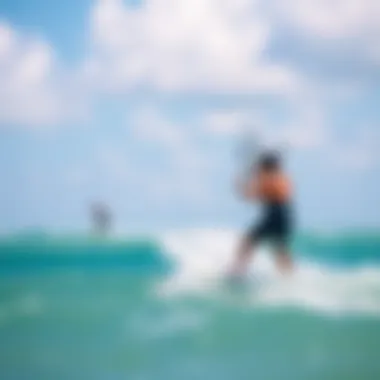

- Qualified instructors: Choose courses led by experienced, certified trainers.
- Practical lessons: Ensure the training includes not just theory but plenty of hands-on experience.
- Safety-first approach: Courses should prioritize safety protocols, equipping learners to handle unexpected situations.
Once trained, it’s essential to not rest on your laurels. Regularly revisiting these skills through refresher courses or community workshops is a helpful way to maintain competence.
Environmental Awareness and Protection
Surf kiting doesn’t exist in a vacuum. As more enthusiasts hit the waters, environmental concerns become increasingly pressing. Understanding the ecological impact of your activities fosters a sense of responsibility. This involves recognizing local wildlife and habitats that face disruption from kiteboarding activities.
Practicing Leave No Trace principles helps in maintaining natural beauty and biodiversity. This means cleaning up after oneself and understanding the seasons of local wildlife, steering clear of sensitive areas.
Considered actions include:
- Minimizing waste during events by using reusable products.
- Participating in environmental initiatives: Engaging in local clean-up events can strengthen community bonds while protecting the environment.
- Educating others: Sharing your knowledge about responsible practices within your social circles encourages a collective effort toward sustainability.
By integrating safety, training, and environmental consciousness into surf kiting, not only do we protect ourselves but also enhance the enjoyment for all who love the sport.
The Community of Surf Kiting Enthusiasts
Surf kiting is not just an exhilarating sport; it's a vibrant community that brings together enthusiasts from various backgrounds. The essence of this community lies in shared passion, knowledge exchange, and collective experiences. For many, it’s a way of life that transcends individual practice. Connecting with others who share the same love for the wind, water, and adrenaline can profoundly enhance one's experience and growth in the sport.
One of the key benefits of engaging with the surf kiting community is the support system that comes with it. Likeminded individuals often uplift each other, share tips, and encourage growth. Newcomers can find mentors who guide them through the initial learning curve, while seasoned riders have the opportunity to refine their techniques and explore advanced maneuvers. The community fosters a culture where everyone can progress and feel welcomed, regardless of their skill level.
Moreover, being part of this passionate network often means gaining access to a wealth of information. From the latest gear recommendations to insights on the best surf spots, community members are keen to exchange experiences. Joining local or online groups can significantly broaden one's horizons, encouraging participation in workshops and trainings that may not be advertised elsewhere.
"A kite can only rise high against the wind; not with it." - Winston Churchill
This quote resonates deeply with the kiting community, emphasizing resilience and camaraderie among enthusiasts.
Events and Competitions: Engaging with the Scene
Events and competitions play a vital role in strengthening the surf kiting community. They create platforms for athletes to showcase their skills and for spectators to appreciate the artistry of this dynamic sport. These gatherings often foster a sense of belonging, allowing participants to interact with others who share the same fervor.
The thrill of competition is not merely about winning; it’s about pushing one’s limits and learning from others. Many events, like the Red Bull King of the Air, attract top talents from around the globe, drawing crowds that can create an electric atmosphere. For local riders, participating in these competitions can lead to significant exposure and connection opportunities within the kiting world.
In addition to the adrenaline-filled contests, community events such as beach clean-ups, workshops, and social gatherings promote environmental awareness and sustainability. These initiatives reflect the community's commitment to preserving the natural beauty that allows surf kiting to thrive.
Online Forums and Support Networks
In today's interconnected world, online platforms serve as vital hubs for surf kiting enthusiasts. These virtual spaces provide community members with opportunities to ask questions, seek advice, and share experiences. Forums and groups on platforms like Reddit or Facebook are often buzzing with discussions about various topics: from gear maintenance to favorite kiting locations.
Moreover, these online networks ensure that knowledge and information flow freely, breaking geographical barriers. An aspiring kiteboarder in Europe, for instance, can instantly connect with experienced kiting professionals in Australia, sharing tips and insights that may be relevant or unique to their local conditions.
Online discussions can delve into more serious subjects too, like safety protocols or the impact of climate change on kiting conditions. By engaging in these dialogues, community members are empowered to take action, not just for their own benefit, but for the collective good of the sport and the environment.
The sense of belonging fostered in both real-life events and online discussions cultivates strong ties among participants. When individuals share their journeys, challenges, or victories, they create an inclusive environment that enriches the sport as a whole. The surf kiting community isn’t just about riding the waves; it’s about riding them together.
Future Trends in Surf Kiting
The landscape of surf kiting is ever-changing, and staying ahead of the curve involves not just adapting to new technologies but also embracing sustainable practices that ensure the longevity of this exhilarating sport. In this section, we dive into what the future holds for surf kiting, focusing on emerging technologies in equipment and sustainable approaches being adopted by the community. Understanding these elements is crucial for kiteboarders, instructors, and event organizers who are committed to the growth and health of the sport.
Emerging Technologies in Equipment
As technology progresses, so too does the equipment used in surf kiting. Innovations abound, offering kiteboarders enhanced performance and greater safety on the water. For example, the implementation of advanced materials has led to lighter kites that provide improved stability without compromising strength. Brands like North Kiteboarding and Duotone are at the forefront, experimenting with materials like ripstop nylon and new structural designs. This not only makes kites easier to handle but also boosts their durability.
Some key advancements include:
- Smart Kites: These are equipped with sensors that provide real-time data on wind conditions and performance metrics, enabling riders to adjust their technique instantaneously.
- Inflatable kites with rapid deflation capabilities: This technology makes it easier to pack up and transport gear, appealing to those who travel frequently.
- Eco-friendly materials: Manufacturers are increasingly focusing on sustainability by utilizing recycled plastics and biodegradable fabrics in kite production.
This technological evolution is not just about performance; it's also about making the sport accessible to a broader audience, particularly newcomers who may feel intimidated by complex gear. As companies innovate, they are also responding to a demand for inclusivity and simplicity, ensuring that the joys of surf kiting are available to all.
Sustainability in the Sport
Sustainable practices are gaining traction in the surf kiting community. As kiteboarders become more conscious of their environmental impact, there's a collective push towards greener practices. The role that sustainability plays is twofold: it addresses the environmental challenges the sport faces while also enhancing its appeal to future generations.
"To maintain the beauty of our coastlines and oceans, we must be proactive in our sustainability efforts."
- Organizations are forming partnerships with environmental groups to create initiatives that focus on beach clean-ups, which encourage community engagement.
- Many kiting events now include environmental awareness components, educating participants about the ecosystems they interact with.
- Several brands are committing to using only sustainable production methods, ensuring a minimal carbon footprint from material sourcing to the final product delivery.
For kiteboarders, adopting more sustainable practices isn’t just about ethics; it can also lead to a deeper connection with nature and the sport. Now more than ever, being aware of how kiting affects marine environments is crucial. The future of surf kiting hinges on this balance—enjoying the thrill of the wind and waves while also protecting them for countless generations to come.
In summary, as we look to the future of surf kiting, embracing emerging technologies and sustainable practices will not only enhance the experience for participants but also ensure that the sport continues to thrive and evolve in harmony with the environment.






